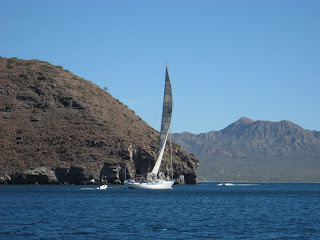 |
| San Evaristo |
 |
| Kialoa III on her way |
Not long after that a large US flagged schooner with 8 people on deck arrived and did a circle looking for an anchoring spot. Fortunately I had made sure that the VHF radio was on because soon the boat hailed us and asked how much scope we had on our anchor rode. "Three Five Meters" was my reply, and the lady seemed satisfied with that, telling me that they also would lay down 35 meters. Soon they were anchored 75 meters seaward of us.
Shortly after lunch I discovered water in the starboard cupboard and shelving. In that short but rough sail from Isla San Francisco 2 or 3 cupfuls of water had leaked from the deck. That may not sound like much but it has a serious practical and psychological effects. If you extrapolate to the long wet conditions to be expected on the run around the Horn the situation is intolerable. I am determined to find the source of the leak during the coming summer in La Paz. That will be more difficult that it sounds because the task is not as simple as playing a water hose on the deck. I told Brenda today that I've got no problem in doing what has to be done, but my problem is in knowing what has to be done. For example, it would be extremely wasteful to re bed the toe rail if it turns out that that wasn't the problem. To find this leak I expect to have to drop the starboard side of the ceiling, empty out the contents on that side, then engage in some serious and systematic hose work, trying to simulate a deck awash, section by section.
We also got water at the forward bulkhead of the V berth area, but the source should be much easier to find now that I have removed that felt material that was lining the area. The forward hatch which Arnold and I installed in New Zealand did not leak a drop.
 |
| Tienda at San Evaristo |
We found that the tienda was stocked with a good supply of fresh fruit and vegetables and we purchased bananas, potatoes, sweet potatoes, and onion. We also got a loaf of Bimbo bread and a packet of cookies. (We forgot to purchase the eggs.) We left the groceries in a cooler bag in the Zodiac and proceeded with the rest of our walk. While approaching the tienda we notice a horse and a mule tied to a rail outside of the shop. Soon a gentleman wearing a sombrero emerged and proceeded to put some serious looking spurs that he had hidden behind a bush. He mounted the mule the rode it to the door of the tienda where he was given his groceries.
 |
| Tienda patron departing |
From there we set off over the hill to look at the salt ponds on the north side of the tiny peninsula. Along the way we had a look at the school. A sign in front declared it to be a voting place this very day, the 6th of February. As in Australia, schools are used as voting venues. However, in Australia voting days are on Saturday, not Sunday. In Mexico, however, Sunday makes sense because the standard work week is 6 days long. That's right: the stereotype of the lazy Mexican spending the day sleeping under his sombrero has been replaced by a standard six-day week in this emerging market economy.
We then walked back to the south end of the village where I asked a pescador if he had any fish for sale. By then the fish had been packed in ice ready for transport so he didn't have any available but he said that he would deliver fish fillets to our boat at 8 AM tomorrow. I'm sorry that I didn't ask for 2 kilos instead of 1.
The only failure was that the palapa that acts as bar and restaurant was closed, no doubt because this is Sunday. However, we'll be back and hopefully have a meal there. We also hope to get some water from the desalination plant tomorrow.
----------
radio email processed by SailMail
for information see: http://www.sailmail.com

No comments:
Post a Comment